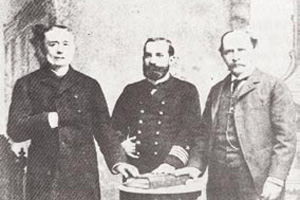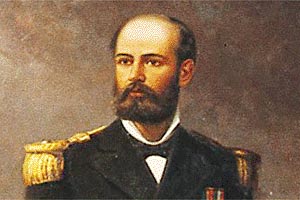On June 15th of 1886, Jose Manuel Balmaceda was chosen president of the Republic, supported by the National, Liberal and part of the Radical party. By assuming his administration (September 18th), he found himself in the middle of a great political breakdown, expressed on many parliamentarian disputes. Therefore, he proposed himself to achieve the union of all the fractions of the Liberal party and obtain national unity. His first cabinet was integrated by Eusebio Lillo in the ministry of the Interior; Joaquin Godoy, in Exterior Relations; Pedro Montt, in Justice; Agustin Edwards Ross, in Finance, and Evaristo Sanchez, in War and Navy.
The economical situation in his government was very prosperous, because the previous ruler (Domingo Santa Maria) had paid the bills of the war of the Pacific and the saltpeter continued increasing its exportation: from 4,510,000 metrical hundredweights in 1886, it increased to 10,751,000 in 1890.
In addition, this financial relief allowed the removal of some taxes, the investing on public works and the stabilizing of the government debt. Moreover, the Chilean credit acquired prestige in Europe that helped having a surplus in the treasury.
It also increased the exploitation of other minerals, such as silver, thanks to the discovering of the mineral deposit Caracoles (between Calama and Antofagasta). Likewise, the construction of the transandino railroad from Los Andes to Mendoza (1887) facilitated the entering of Argentinean products, especially, cattle. With the pacifying of the Araucania, the lands of the south of the country could be used for agriculture.
Public works
During his government, the Ministry of Public Works was created (1887), which managed to materialize important buildings and road works. Some of them were the following:
– Construction of more than 1,000 kilometers of railroads and many bridges, such as the Malleco viaduct (inaugurated in 1890).
– In Santiago, many buildings were raised: the Escuela de Medicina of Universidad de Chile, the Internado de Santiago (known today as Barros Arana), the Consejo de Enseñanza Técnica e Industrial, the Escuela Militar, the Clinical Hospital for women, the Public Prison, the Normal School of Preceptresses and the School of Arts and Crafts. In addition, the canalization of the Mapocho river was made.
– In the north, important works were built, such as the Liceo de hombres of Iquique, the Normal School of Preceptresses and the City Council in La Serena.
– There were also planned constructions in the southern central part of the country: In Talca, the City Council and the Penitentiary; in Chillan, the School of Preceptors and in Concepcion, the Mail and Telegraph building.
– Coverage of drinking water was given to 15 cities and studies were initiated to favor 36 other cities.
Educational matters
Balmaceda introduced important changes in the Chilean educational system. Some of them were the following:
– German influence: the triumph of Germany over France in the war of 1870 provoked the ending of the influence gala in the Chilean educational system, being replaced by the German pedagogy.
– Universidad Catolica (1888): was the first private educational center of higher studies founded in our country. It was a work of monsignors Joaquin Larrain Gandarillas and Mariano Casanova.
– Concentric system of education (1889): the minister of Justice and Instruction, Julio Bañados, decreed the implementation of a system that consisted in the grouping of subjects belonging to the same order of knowledge, for progressive studies from the first until the sixth year. Foundation of the Instituto Pedagogico (1889): it was created because it was impossible to continue trusting the classes of schools to people without methodological preparation.
Revolution of 1891
The increasing of the power achieved by Congress during the last years and the confrontation of it with the president made a crisis in 1890, when Balmaceda tried to reform the Constitution to eliminate all the traces of the parliamentarianism. In addition, the new cabinet, headed by Salvador Fuentes, was rejected by Congress.
In the presence of this situation, Balmaceda refused to name new ministers, arguing that, according to the Carta Fundamental, they had a position of trust.
This new conflict extended in time, and the ordinary sessions of Congress concluded without setting fort the Budgetary law for 1891. On January 5th of 1891, Balmaceda set out that the same budget from the previous year would rule in the new year, act which was considered unconstitutional by his opposers, thus resulting in his dismissal from his position as the president by the Parliament.
Civil war
Two days after requesting the destitution of Balmaceda, the National Squadron joined the anti-balmacedista movement, setting sail from Valparaiso towards Iquique with the armored Cochrane and Blanco Encalada, the Esmeralda cruise ship, the O’Higgins sloop and the Magallanes gunboat. Later, the Huascar and the Abtao sloop joined them.
In addition, they seized the ships of the Compañía Sudamericana de Vapores (South American Steam Company) and the Compañía de Lota (Lota Company).
Once they were in Iquique, a revolutionary council was constituted, formed by the ship captain Jorge Montt, the vice-president of the Senate, Waldo Silva, and the president of the Chamber of Deputies, Ramon Barros Luco.
The most important military clashes between the balmacedistas and congresistas were the combats of Dolores (February 15th of 1891), Huara (February 17th) and Pozo Almonte (March 7th) and the naval combats of Caldera and Calderillas (April 23rd). After these difficult fights, the congresistas triumphed over the forces of the government, achieving the command of the north of the country.
After this last event, the congresistas dedicated themselves to reinforce their troops (using the money of the saltpeter taxes), while the balmacedistas were doing the same in the capital.
In august of 1891, the congressional army disembarked in Quintero triumphing in the battles of Concon (August 21st) and Placilla (August 28th).
After the defeats of their supporters, Balmaceda gave his command to the general Manuel Baquedano (August 28th), left his family in the embassy of the United States and later shelter himself in the Argentinean legation.
In that place he asked to the governing council the legal warranties corresponding to the position that he had performed for 5 years, but it was denied.
On September 18th – the same day that his constitutional ruling ended – he dressed in black and lay down in his bed, where he committed suicide. With this event, the period of the Liberal Republic ended and started the period known as the Parliamentarian Republic, where the directing class, the bourgeoisie and the aristocracy were over the Executive.





